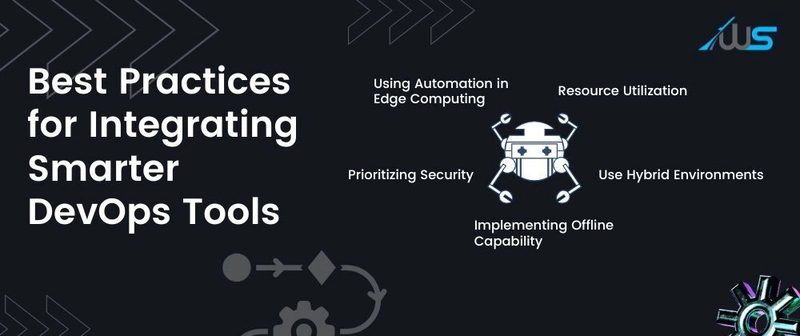Tackling Decentralized Challenges with Smarter Tools
Are you facing challenges like Security Scalability Infrastructure Data management Then relax a bit! By integrating DevOps into edge computing you can mitigate these decentralized computing challenges. So,You might wonder! what exactly is edge computing? Edge computing is a decentralized framework that reduces proximity between data storage and processing and the user or data source. Unlike traditional cloud computing models, this approach enhances processing speed and minimises network congestion, ensuring smoother performance across all applications. These capabilities are crucial in scenarios where even minor delays can cause major consequences. This blog will explore the overlap between Edge Computing and DevOps, the challenges, and the best practices for its integration So, without further delay, let's dive deep into it. The Role of DevOps in Edge Computing DevOps is crucial to facilitate smooth operations in an Edge Computing ecosystem, and here’s why: 1. Automation DevOps automation practices, particularly CI/CD pipelines are instrumental in enabling DEI (Distributed Edge Infrastructure), ensuring smooth deployments and updates. CI/CD pipelines deploy configuration changes, software updates, and patches to edge nodes without human intervention. Automation guarantees consistent and predictable updates across thousands of edge nodes, allowing the edge network to scale rapidly and efficiently. Plus, automated testing guarantees un-disrupted application deployment. 2. Collaboration Edge computing and DevOps foster collaboration between developers and operations teams to effectively manage the complexities of distributed edge systems. Apps should work smoothly across isolated, unreliable, and remote Edge Computing ecosystems. This improved collaboration allows teams to pool their knowledge and insights, optimizing workflows and enabling swift responses to challenges. This collaboration is crucial during application rollout, ensuring smooth and uninterrupted delivery throughout edge nodes. 3. Scalability As more and more organizations uses edge devices, scalability becomes crucial. DevOps tools like container orchestration platforms like Docker and Kubernetes make edge computing ecosystems scalable, enabling optimal resource usage. Additionally, tools as Kubernetes enable the deployment of containerized apps throughout the distributed networks of edge devices. Lightweight containers guarantee portability, rapid scaling, and flexible app management while maintaining system integrity. Decentralized Computing Challenges While Edge computing and DevOps hold promise, they can bring in challenges. Businesses must consider these challenges for a successful integration. Distributed Infrastructure When edge infrastructure spans vast geographic regions, maintaining consistent deployment, updates, and configuration management becomes a significant challenge. Ensuring that every edge node stays up-to-date with the latest configurations and software updates is a critical challenge. Conventional centralized management platforms might not be apt for a distributed environment. Resource Constraints Edge devices operate in environments with limited resources. These include limited storage, energy supply, and processing power. This is a challenge for DevOps tools demanding more resource than what is available in the Edge ecosystem. Hence, embracing resource-efficient DevOps practices is essential for successful integration. Security Threats Edge computing's decentralized architecture increases its exposure to security threats. In these architectures, each node is vulnerable to attacks, making it hard to implement a security strategy. Cyber-security risks like data breaches, communication network attacks, and unauthorized access can pose integrity threats to edge systems. Mitigating these risks demands robust security measures throughout every stage of the development and deployment process. These measures include 2FA, security patches, encryption, and constant vulnerability assessment. Security monitoring tools, AI anomaly detection will enable faster threat detection. This will allow easier prevention of real-time cyber-attacks. Network Reliability Edge devices work in unreliable connectivity environments like mobile networks or remote locations. This can cause deployment, integration, and monitoring shutdown. Robust architectures that enable data synchronization and offline-first functionality can help overcome connectivity issues. Developers should design edge applications to function seamlessly during connectivity loss and sync with the central system once the connection is restored. Tools like Git for DVCand caching mechanisms can help ensure consistency and reliability during network disruptions. Benefits of Edge Computing and DevOps Instead of the challenges in integration, the combination can offer various benefits: Improved Efficiency:

Are you facing challenges like
- Security
- Scalability
- Infrastructure
- Data management
Then relax a bit! By integrating DevOps into edge computing you can mitigate these decentralized computing challenges.
So,You might wonder! what exactly is edge computing?
Edge computing is a decentralized framework that reduces proximity between data storage and processing and the user or data source.
Unlike traditional cloud computing models, this approach enhances processing speed and minimises network congestion, ensuring smoother performance across all applications. These capabilities are crucial in scenarios where even minor delays can cause major consequences.
This blog will explore the overlap between Edge Computing and DevOps, the challenges, and the best practices for its integration
So, without further delay, let's dive deep into it.
The Role of DevOps in Edge Computing
DevOps is crucial to facilitate smooth operations in an Edge Computing ecosystem, and here’s why:
1. Automation
DevOps automation practices, particularly CI/CD pipelines are instrumental in enabling DEI (Distributed Edge Infrastructure), ensuring smooth deployments and updates. CI/CD pipelines deploy configuration changes, software updates, and patches to edge nodes without human intervention.
Automation guarantees consistent and predictable updates across thousands of edge nodes, allowing the edge network to scale rapidly and efficiently. Plus, automated testing guarantees un-disrupted application deployment.
2. Collaboration
Edge computing and DevOps foster collaboration between developers and operations teams to effectively manage the complexities of distributed edge systems. Apps should work smoothly across isolated, unreliable, and remote Edge Computing ecosystems.
This improved collaboration allows teams to pool their knowledge and insights, optimizing workflows and enabling swift responses to challenges. This collaboration is crucial during application rollout, ensuring smooth and uninterrupted delivery throughout edge nodes.
3. Scalability
As more and more organizations uses edge devices, scalability becomes crucial. DevOps tools like container orchestration platforms like Docker and Kubernetes make edge computing ecosystems scalable, enabling optimal resource usage.
Additionally, tools as Kubernetes enable the deployment of containerized apps throughout the distributed networks of edge devices. Lightweight containers guarantee portability, rapid scaling, and flexible app management while maintaining system integrity.
Decentralized Computing Challenges
While Edge computing and DevOps hold promise, they can bring in challenges. Businesses must consider these challenges for a successful integration.
Distributed Infrastructure
When edge infrastructure spans vast geographic regions, maintaining consistent deployment, updates, and configuration management becomes a significant challenge. Ensuring that every edge node stays up-to-date with the latest configurations and software updates is a critical challenge. Conventional centralized management platforms might not be apt for a distributed environment.
Resource Constraints
Edge devices operate in environments with limited resources. These include limited storage, energy supply, and processing power. This is a challenge for DevOps tools demanding more resource than what is available in the Edge ecosystem. Hence, embracing resource-efficient DevOps practices is essential for successful integration.
Security Threats
Edge computing's decentralized architecture increases its exposure to security threats. In these architectures, each node is vulnerable to attacks, making it hard to implement a security strategy. Cyber-security risks like data breaches, communication network attacks, and unauthorized access can pose integrity threats to edge systems.
Mitigating these risks demands robust security measures throughout every stage of the development and deployment process. These measures include 2FA, security patches, encryption, and constant vulnerability assessment. Security monitoring tools, AI anomaly detection will enable faster threat detection. This will allow easier prevention of real-time cyber-attacks.
Network Reliability
Edge devices work in unreliable connectivity environments like mobile networks or remote locations. This can cause deployment, integration, and monitoring shutdown. Robust architectures that enable data synchronization and offline-first functionality can help overcome connectivity issues.
Developers should design edge applications to function seamlessly during connectivity loss and sync with the central system once the connection is restored. Tools like Git for DVCand caching mechanisms can help ensure consistency and reliability during network disruptions.
Benefits of Edge Computing and DevOps
Instead of the challenges in integration, the combination can offer various benefits:
Improved Efficiency:
Automation provided by DevOps can enhance Edge Computing efficiency. Automated testing, integration, and deployment processes can minimize human intervention and downtime, ensuring reliable and consistent delivery of apps with reduced operational expenses and quick time-to-market.
Enhanced UX:
Edge computing brings data processing nearer to the end user. Low-latency apps with Instant data processing can be possible. This results in enhanced UX, as apps respond rapidly to the action of the users.
Scalability:
DevOps enables organizations to expand edge deployments while maintaining performance. With deployment automation and management tools, businesses can quickly improve the edge infrastructure to introduce new apps and devices by dynamic resource allocation.
Innovation:
Edge computing and DevOps integration promotes innovation, which is made possible by the fast prototyping of new apps. Businesses can rapidly refine these concepts, develop innovative solutions, and implement them in practical edge ecosystems. For example, organizations can leverage predictive assessment to allow new services or enhance operations.
Resilience:
DevOps concepts like automated recovery, fault tolerance, and constant monitoring improve the edge system resilience. Live issue detection, self-recovering systems, and automated health checks guarantee operational systems even during network or hardware failures.
Best Practices for Integrating Smarter DevOps Tools
To successfully combine Edge Computing and DevOps, you can consider the following best practices:
Using Automation in Edge Computing
You have to automate the maximum process including integration, testing, monitoring, and deployment. CI/CD pipelines must be adapted to address the unique challenges of edge computing ecosystems.
Resource Utilization
Given the limitations of edge devices, it's essential to maximize resource efficiency by leveraging lightweight containers, applications, and microservices. Appropriate resource allocation and optimized coding techniques will enable effective edge node performance without overburdening.
Prioritizing Security
You have to prioritize security throughout development and deployment pipeline. This involves safeguarding devices, data creation processes, and communication pathways. Regularly implement robust encryption protocols, conduct vulnerability assessments, and enforce secure access controls.
Use Hybrid Environments
By integrating Edge Computing with DevOps, businesses can harness the advantages of both by blending cloud infrastructure with edge capabilities. With multi-cloud or hybrid ecosystems, businesses can shift heavy computation tasks to the cloud while keeping time-sensitive processing locally.
Implementing Offline Capability
Ensuring the device continues operations even during network issues is vital. It will ensure business continuity, working in an intermittent or remote network.
Wrapping Up
Edge Computing and DevOps are two game-changing technologies reshaping the digital ecosystem. Adopting DevOps practices in Edge Computing solutions enables businesses to meet their efficiency, scalability and performance needs.
Challenges like resource constraints, security risks, and distributed infrastructure persist. However, opportunities like innovation, system resilience, and improvements in UX are far superior to these challenges. By adopting best practices like automation and fostering collaboration, businesses can navigate the complexities, realizing their maximum potential and achieving operational excellence.






































































































































































![[The AI Show Episode 146]: Rise of “AI-First” Companies, AI Job Disruption, GPT-4o Update Gets Rolled Back, How Big Consulting Firms Use AI, and Meta AI App](https://www.marketingaiinstitute.com/hubfs/ep%20146%20cover.png)

















































































































































































.jpg?width=1920&height=1920&fit=bounds&quality=70&format=jpg&auto=webp#)






















































































_Alexey_Kotelnikov_Alamy.jpg?width=1280&auto=webp&quality=80&disable=upscale#)
_Brian_Jackson_Alamy.jpg?width=1280&auto=webp&quality=80&disable=upscale#)



 Stolen 884,000 Credit Card Details on 13 Million Clicks from Users Worldwide.webp?#)


























































































![Roku clarifies how ‘Pause Ads’ work amid issues with some HDR content [U]](https://i0.wp.com/9to5google.com/wp-content/uploads/sites/4/2025/05/roku-pause-ad-1.jpg?resize=1200%2C628&quality=82&strip=all&ssl=1)













![Apple Seeds visionOS 2.5 RC to Developers [Download]](https://www.iclarified.com/images/news/97240/97240/97240-640.jpg)
![Apple Seeds tvOS 18.5 RC to Developers [Download]](https://www.iclarified.com/images/news/97243/97243/97243-640.jpg)







































































































